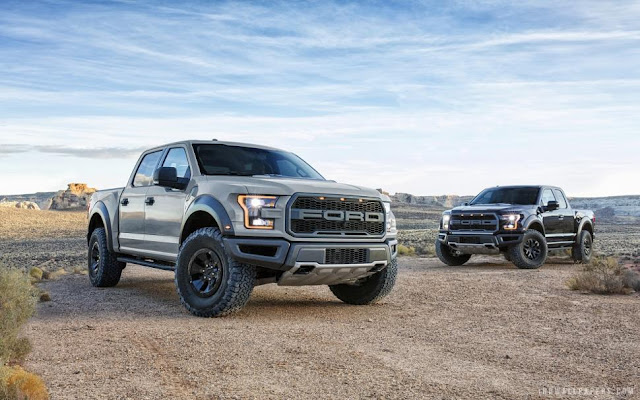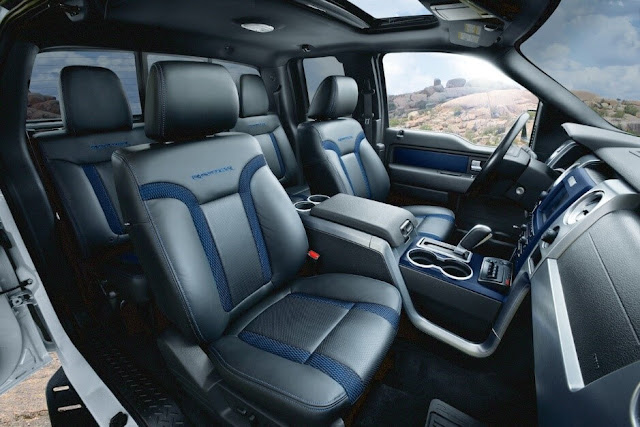Ford Raptor
Ford revealed the 2009 F-150 design at the 2008 North American International Auto Show in Detroit.
Development began under chief engineer Matt O'Leary in November 2003
under the code name "P-415", after P-221 production began in June 2003.[3]
General design work was done under Patrick Schiavone into late 2005,
with further exterior changes taking place during late 2006 to the
tailgate design and wheel lip arches during a development hiatus. The
final design freeze later took place in early 2007.[4] Production of the series began in October 2008 at Ford's Kansas City Assembly Plant.[5]
Ford originally planned to expand the F-Series platform by reintroducing the F-100 as a midsize truck. Known internally as P525, the F-100 would have served as the global replacement for Ford Ranger in 2010 or 2011,[6] The project was ultimately shelved, with the company developing the Ranger T6 as a global midsize truck and in North America, Ford focused on developing fuel-efficient powertrains such as the EcoBoost V6 and the 6-speed automatic transmission for the F-150.[7]
The 2009 F-150 featured a larger and more flexible interior, an updated three-bar grille, and additional choices of trim levels. The chassis included lighter-weight, high-strength steel for better fuel economy and safety and improved payload and towing capacity. For the first time in the history of the F-Series, a V8 engine was standard in all models; no 6-cylinder was available. Regular cab models were once again produced with standard-length doors rather than two short, rear-opening doors. All Flareside models in 2009 were made with new badging on the previous generation's boxes and were discontinued at the end of the model year when stock had run out, echoing a similar situation in the first year of the eighth generation.
In 2009, the SVT Raptor off-road truck was introduced. Initially available as a Supercab with a unique 5.5-foot box, it was available with either a 320-hp 5.4L V8 or an optional 411-hp 6.2L V8 from the Super Duty line. The standard wheel of FX4 models was enlarged to 18".
2011 marked a major upgrade to the powertrain lineup. In the interest of increasing fuel economy, both versions of the 4.6L V8 and the 5.4L V8 were discontinued. In their place were a 3.7L V6 and a 5.0L V8. Between the two engines was an all-new 3.5L twin-turbocharged V6. Dubbed EcoBoost, the 3.5L V6 produced 365 hp.
For 2012, the F-150 sported a ten-grade lineup (XL, STX, XLT, FX2, FX4, Lariat, King Ranch, Platinum, Harley-Davidson and SVT Raptor).
For 2013, the F-150 received minor changes such as 3 new grilles (replacing all 4 previous grilles), new optional 18-, 20-, or 22-inch wheels, Sync with MyFord, MyFord Touch navigation system, new power-folding and telescoping trailer tow mirrors (taken from the Super Duty models), high-intensity discharge headlamps, 3 new color options (Blue Jeans Metallic, Kodiak Brown Metallic and Ruby Red Clearcoat Metallic), new Alcantara seats in the FX Appearance Package, black or pecan leather in Platinum, the return of the Limited model and the 6.2-liter V8 being made available in XLT, FX2, and FX4 (SuperCab and SuperCrew only).
For 2014, a special truck called the Tremor was introduced, essentially an EcoBoost-equipped FX2 or FX4 truck in a regular cab model with a 6.5' bed, a special FX Appearance Package, a flow-through center console with bucket seats and a 4.10 rear gear final drive ratio.
Also new in 2014, the STX trim level also became available on SuperCrew models with the 5.5' box. In addition an STX Sport package was added for 2014 including 20" wheels, black cloth seats, and black exterior accents.[8]
Ford originally planned to expand the F-Series platform by reintroducing the F-100 as a midsize truck. Known internally as P525, the F-100 would have served as the global replacement for Ford Ranger in 2010 or 2011,[6] The project was ultimately shelved, with the company developing the Ranger T6 as a global midsize truck and in North America, Ford focused on developing fuel-efficient powertrains such as the EcoBoost V6 and the 6-speed automatic transmission for the F-150.[7]
The 2009 F-150 featured a larger and more flexible interior, an updated three-bar grille, and additional choices of trim levels. The chassis included lighter-weight, high-strength steel for better fuel economy and safety and improved payload and towing capacity. For the first time in the history of the F-Series, a V8 engine was standard in all models; no 6-cylinder was available. Regular cab models were once again produced with standard-length doors rather than two short, rear-opening doors. All Flareside models in 2009 were made with new badging on the previous generation's boxes and were discontinued at the end of the model year when stock had run out, echoing a similar situation in the first year of the eighth generation.
In 2009, the SVT Raptor off-road truck was introduced. Initially available as a Supercab with a unique 5.5-foot box, it was available with either a 320-hp 5.4L V8 or an optional 411-hp 6.2L V8 from the Super Duty line. The standard wheel of FX4 models was enlarged to 18".
2011 marked a major upgrade to the powertrain lineup. In the interest of increasing fuel economy, both versions of the 4.6L V8 and the 5.4L V8 were discontinued. In their place were a 3.7L V6 and a 5.0L V8. Between the two engines was an all-new 3.5L twin-turbocharged V6. Dubbed EcoBoost, the 3.5L V6 produced 365 hp.
For 2012, the F-150 sported a ten-grade lineup (XL, STX, XLT, FX2, FX4, Lariat, King Ranch, Platinum, Harley-Davidson and SVT Raptor).
For 2013, the F-150 received minor changes such as 3 new grilles (replacing all 4 previous grilles), new optional 18-, 20-, or 22-inch wheels, Sync with MyFord, MyFord Touch navigation system, new power-folding and telescoping trailer tow mirrors (taken from the Super Duty models), high-intensity discharge headlamps, 3 new color options (Blue Jeans Metallic, Kodiak Brown Metallic and Ruby Red Clearcoat Metallic), new Alcantara seats in the FX Appearance Package, black or pecan leather in Platinum, the return of the Limited model and the 6.2-liter V8 being made available in XLT, FX2, and FX4 (SuperCab and SuperCrew only).
For 2014, a special truck called the Tremor was introduced, essentially an EcoBoost-equipped FX2 or FX4 truck in a regular cab model with a 6.5' bed, a special FX Appearance Package, a flow-through center console with bucket seats and a 4.10 rear gear final drive ratio.
Also new in 2014, the STX trim level also became available on SuperCrew models with the 5.5' box. In addition an STX Sport package was added for 2014 including 20" wheels, black cloth seats, and black exterior accents.[8]






Comments